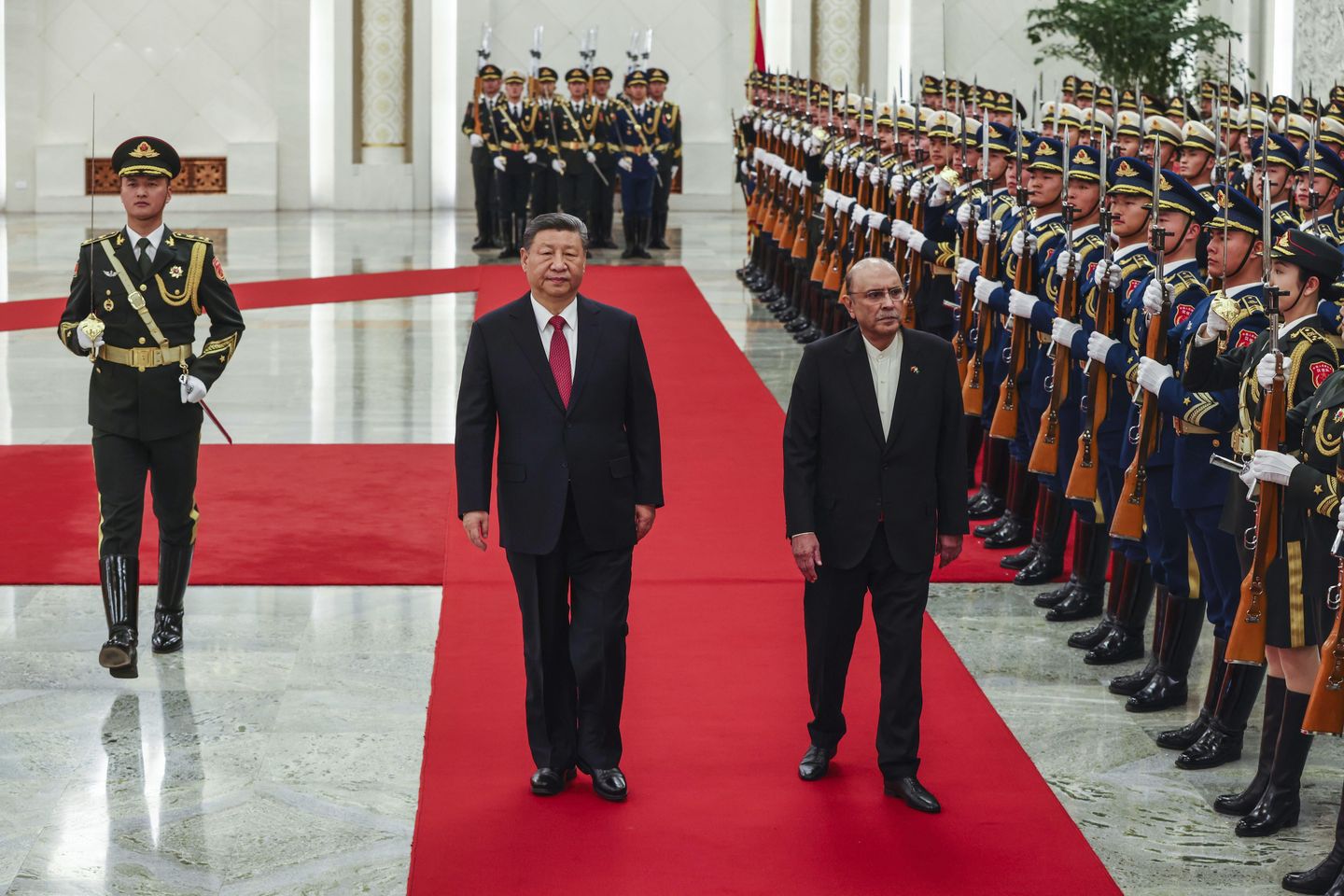
SEOUL, South Korea — It is no easy call to decide which nation “won” the recent conflict between India and Pakistan, but China, thanks to the apparent successes of its equipment sold to Pakistan, has earned a bonanza of bragging rights.
Alarms are ringing.
On a recent Washington Times panel, Sen. Tim Sheehy, Montana Republican and an ex-Navy SEAL, said, “Pakistan appears to have won every engagement so far with Chinese technology against the largely Western technology used by India,” adding, “That’s not good for us.”
One expert, however, suggested that early analyses are simplistic. India also fields Russian fighters and S-400 air defense systems — which appear to have been effective.
The expert suggested Pakistan’s claimed kills of advanced Western fighters with Chinese kit may have resulted from speedy escalation, rather than technical superiority.
Regardless, purported Pakistani kills by Chinese-made fighters and air-to-air missiles, of as many as three Rafales, made by French arms manufacturer Dassault, have surprised many. Publicity surrounding the allegations has granted kudos to Beijing’s arms makers.
Chinese forces were untested in combat since 1988, so Beijing armorers could not claim that their products were battle-proven. They can now — and more may be incoming.
The four-day clash between the nuclear powers has ended, but sources say pundits should keep eyes on: New Delhi is likely to use a similar strike model going forward.
Battle in subcontinental skies
After Islamic militants killed 26 people in India-controlled Kashmir on April 22, New Delhi accused Islamabad of links to the terrorists. Islamabad denied it.
On May 7, India unleashed aerial attacks on what it claimed were nine terrorist-linked sites inside Pakistan. Pakistan responded, claiming its jets shot down five or six Indian fighters — both French and Russian models.
With India silent on losses, multiple leaks to the media suggest three Indian airframes were likely downed. Images of debris on social media in India suggest one Indian Rafale, at a minimum, crashed.
Cross-frontier clashes with artillery, drones and missiles continued until both sides pulled back from the brink on May 10 after U.S. diplomatic intervention.
All indications are that air-air clashes took place with both sides’ jets firing stand-off weapons from their own airspace, meaning crash debris and ejecting pilots would land on friendly territory. Pakistan has been unable to show identifiable remains of crashed Indian fighters.
Pakistan deployed, among other assets, Chinese-made J-10C “Furious Dragon” fighters armed with long-range PL-15 air-to-air missiles.
Neither the J-10C nor the Rafale is a 5th generation fighter like the U.S. F-35 and the Chinese J-20 — stealth models more survivable than fourth generation fighters. Even so, the latter are sophisticated machines: examples include J-10, Rafale, Eurofighter’s Typhoon, Russia’s MIG-29 and U.S. F-16.
Beyond ground control, training and pilot skillset, one question is whether Chinese equipment was superior, or whether cautious Indian doctrine enabled Pakistani successes in the conflict’s early hours.
A source familiar with defense matters, who talked anonymously as he lacks permission to speak to the media, suggested speed of escalation, rather than technical excellence in airframes, avionics and missile range, may be central.
“Pakistan fired on Indian aircraft and seemed to catch them by surprise,” the source said. “In the initial stages of the operation, the Indians targeted terrorist training camps; they did not try and attrite military targets.”
That, plus India’s non-suppression of Pakistani air defenses, indicate tight rules of engagement.
“Were they instructed they could not fire on Pakistani aircraft that they had tracked?” the person asked. “If that’s the case, Pakistan won via ROE escalation.”
Even so, the source conceded, “If a J-10 fired at a Rafale and downed it, it was an effective kill shot.”
“I think India sought to demonstrate restraint,” agreed Alex Neill, a security expert with Pacific Forum. “What was interesting is both sides demonstrated escalation management.”
With Pakistani forces engaged, India expanded its strikes, hitting air bases and also Rawalpindi, the site of the Pakistanis’ military HQ and close to the capital, Islamabad, before the battle ceased.
‘Watershed moment’ for Beijing
China wields the world’s largest armed forces and possesses a massive military industrial complex. It was also the world’s fourth-largest arms exporter from 2020-2024, per data site Statista, behind the U.S., France and Russia.
However, it has not fought a war since 1979, when a botched, bloody intervention against Vietnam showcased tactical shortfalls. It has not fired a shot in anger since 1988 when it won a limited air-sea clash in the South China Sea, again against Vietnam.
That may explain, in part, why China, per Statista, only sells 5.9 percent of global arms — far behind the U.S. with 43 percent.
In closed-door discussions, at arms markets and in brochure copy, American, European, Iranian, Russian and even North Korean arms makers can truthfully say their kit is “combat tested.”
China could not. It can now.
The J-10 is a “fighter of national pride,” state media Global Times wrote on Monday. Comparing technological innovations in aerospace, quantum computing and high-speed trains to China’s earlier, low-tech exports, it added, “The world has witnessed the transformation of ‘Made in China’ to ‘Intelligent Manufacturing in China.’”
“It represents a watershed movement: China’s military industrial base has produced something that can defeat something produced by the West,” said Mr. Neill. “Obviously, there are caveats in terms of command and control, training and all that, but. … China can demonstrate that it produces goods that are genuinely competitive in global defense markets.”
Mr. Neill said China often exports arms in packages, noting that the Pakistani Air Force has trained with Chinese pilots. It is unclear whether China will leverage the publicity wave.
“It’s a win for the Chinese defense industry: They can demonstrate reliability and efficiency, which a number of potential buyers around the world demand,” he said. “It will ultimately be controlled by Central Military Commission and the Poltiburo Standing Committee as to how they wield this potential win in markets.”
Looking ahead, a senior Indian naval officer said tactical aerial strikes without ground intervention provided a model that could be repeated in the event of future terrorist actions linked to Islamabad.
The anonymous source agreed that Indo-Pakistani air clashes could become a “new normal.” Meanwhile, combat data and “sensor fusion” — combining ground and air assets to create a single picture for air defense — data hold important learnings for other countries facing Chinese arms, such as Taiwan, he said.


![Trump Posts Hilarious Pope Meme, Leftists Immediately Melt Down [WATCH]](https://www.right2024.com/wp-content/uploads/2025/05/Trump-Posts-Hilarious-Pope-Meme-Leftists-Immediately-Melt-Down-WATCH-350x250.jpg)



![Bessent Exposes Media Lies About April’s Stock Market Performance [WATCH]](https://www.right2024.com/wp-content/uploads/2025/04/Bessent-Exposes-Media-Lies-About-Aprils-Stock-Market-Performance-WATCH-350x250.jpg)

![Taylor Swift Slams Subpoena in Blake Lively’s Explosive Legal Battle [WATCH]](https://www.right2024.com/wp-content/uploads/2025/05/1746936931_Taylor-Swift-Slams-Subpoena-in-Blake-Livelys-Explosive-Legal-Battle-350x250.jpg)

![Eric Adams Pushes Back on Schumer’s Coast Guard Cutback Claims After Brooklyn Bridge Tragedy [WATCH]](https://www.right2024.com/wp-content/uploads/2025/05/Eric-Adams-Pushes-Back-on-Schumers-Coast-Guard-Cutback-Claims-350x250.jpg)
![Wild Road Rage Brawl Erupts in Milwaukee [WATCH]](https://www.right2024.com/wp-content/uploads/2025/05/Road-Rage-Turns-Violent-in-Oregon-Minivan-Mows-Down-Motorcyclist-350x250.jpg)





